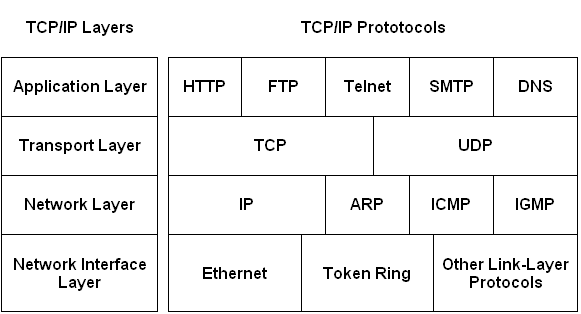The TCP/IP Protocol Framework
Like the seven-layer OSI Reference Model, TCP/IP protocols are based on a layered framework. TCP/IP has four layers, as shown in table below. These layers are described in the following sections.

Network Interface layer
The lowest level of the TCP/IP architecture is the Network Interface layer. It corresponds to the OSI's Physical and Data Link layers. You can use many different TCP/IP protocols at the Network Interface layer, including Ethernet and Token Ring for local area networks and protocols such as X.25, Frame Relay, and ATM for wide area networks.
The Network Interface layer is assumed to be unreliable.
Network layer
The Network layer is where data is addressed, packaged, and routed among networks. Several important Internet protocols operate at the Network layer:
Internet Protocol (IP):
A routable protocol that uses IP addresses to deliver packets to network devices. IP is an intentionally unreliable protocol, so it does not guarantee delivery of information.
Address Resolution Protocol (ARP):
Resolves IP addresses to hardware MAC addresses.
Internet Control Message Protocol (ICMP):
Sends and receives diagnostic messages. ICMP is the basis of the ubiquitous Ping command.
Internet Group Management Protocol (IGMP):
Used to multicast messages to multiple IP addresses at once.
Transport layer
The Transport layer is where sessions are established and data packets are exchanged between hosts. Two core protocols are found at this layer:
Transmission Control Protocol (TCP):
Provides reliable connectionorienteds transmission between two hosts. TCP establishes a session between hosts, and then ensures delivery of packets between the hosts.
User Datagram Protocol (UDP):
Provides connectionless, unreliable, one-to-one or one-to-many delivery.
Application layer
The Application layer of the TCP/IP model corresponds to the Session, Presentation, and Application layers of the OSI Reference Model. A few of the most popular Application layer protocols are:
Hypertext Transfer Protocol (HTTP):
The core protocol of the World Wide Web.
File Transfer Protocol (FTP):
A protocol that enables a client to send and receive complete files from a server.
Telnet:
The protocol that lets you connect to another computer on the Internet in a terminal emulation mode.
Simple Mail Transfer Protocol (SMTP):
One of several key protocols that are used to provide e-mail services.
Domain Name System (DNS):
The protocol that allows you to refer to other host computers by using names rather than numbers.
